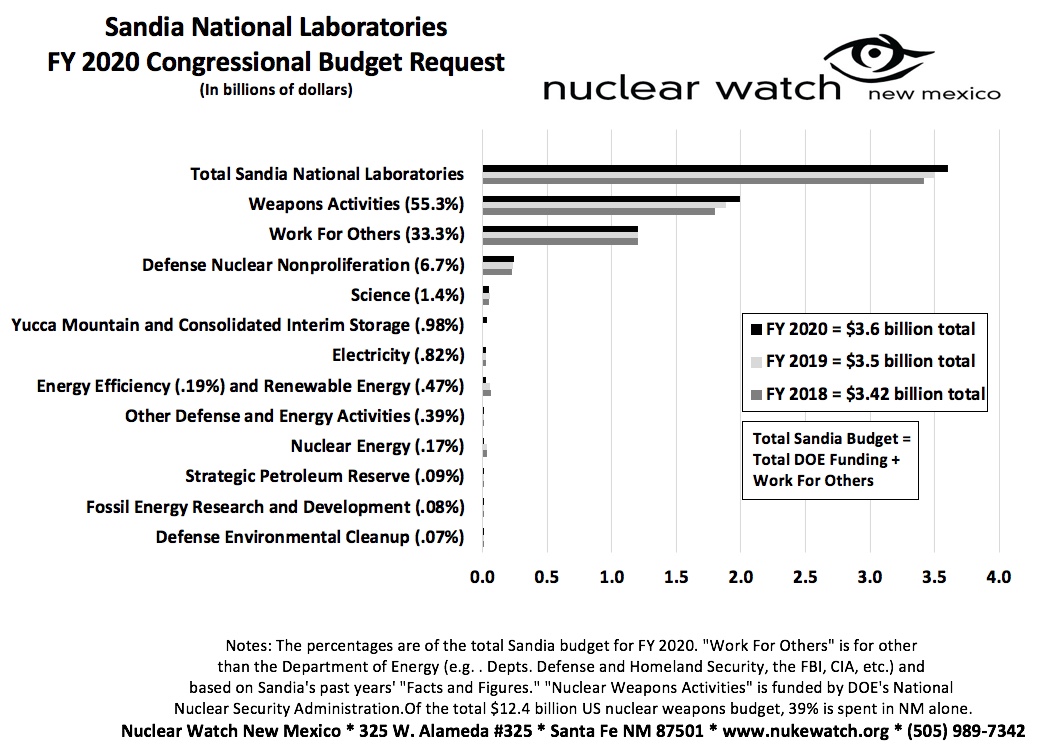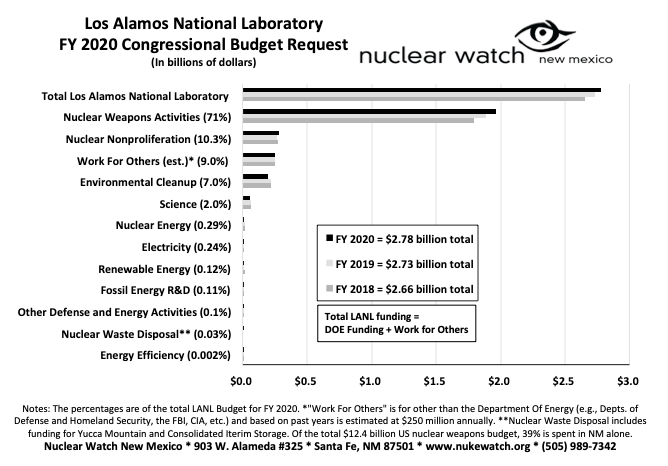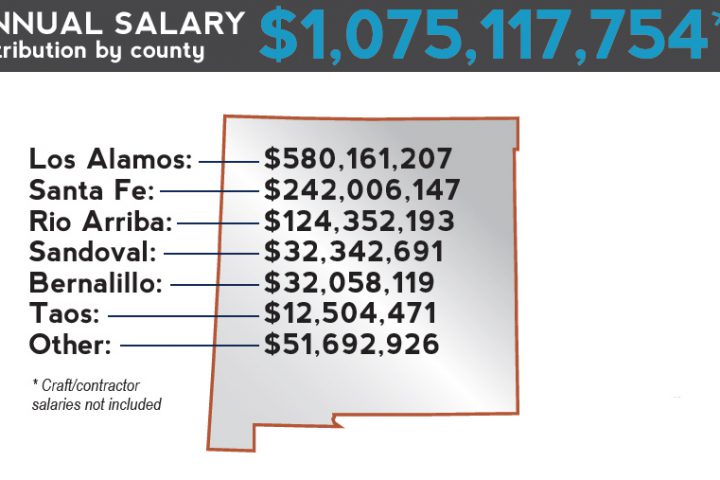Posted by Scott Kovac – Sandia National Laboratories, has one of the Department Of Energy’s (DOE’s) largest annual budgets and the fiscal year 2020 (FY20) Congressional Budget Request shows continued military priorities for the Lab. There are two components of Sandia’s annual budget – work for DOE (with a $2.4 billion request for FY20) and ‘Work For Others’ (with an annual request of $1.2 billion). Sandia’s work for DOE centers around nuclear weapons engineering. ‘Work for Others’ (WFO) is work done for federal agencies other than the DOE and for non-federal entities. An annual total budget of $3.6 billion puts Sandia’s budget second only behind Washington Headquarters among DOE sites.
Author: Scott Kovac
Nuclear Weapons Spending at Los Alamos Is 71% of Annual Budget
By Scott Kovac Los Alamos National Laboratory is first and foremost a nuclear weapons laboratory. The Department of Energy’s annual Congressional Budget Request for fiscal year 2020 shows that 71% of the Lab’s budget will go to nuclear weapons work if Mr. Trump has his way. While cleanup of Cold War wastes would be 7%. And electrical transmission research along with renewable energy and energy efficiency research were slashed to a mere 0.36% of the request for the Lab. As the country goes deeper in debt, we must let go of the old Cold War mentality and invest in our future.
The full Budget Laboratory Tables are Here
Or see our condensed version Here
Trump Budget Would Continue Nuclear Weapons Buildup and Bring More Nuclear Waste to NM
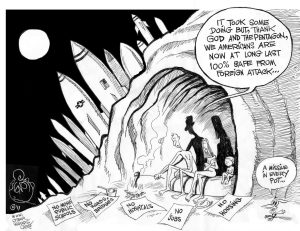
By Scott Kovac, Operations and Research Director
The White House released the top line numbers of its fiscal year 2020 Congressional budget request and, although there are some increases heading to New Mexico, they are not the increases that we’d like to see. It’s called – A Budget For a Better America, Promises Kept. Taxpayers First. but only Defense and Department of Energy (DOE) weapons contractors are going to think that anything is better. Meanwhile the rest of us taxpayers will, first and foremost, be looking at cuts to programs that affect us daily.
WIPP Receives Notice of Upcoming Investigation for Chemical Overexposures to Workers
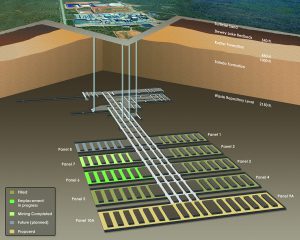
On January 29, 2019, DOE’s Office of Enterprise Assessments notified Nuclear Waste Partnership, LLC (NWP), the managing and operating contractor for the Waste Isolation Pilot Plan (WIPP), of its intent to investigate heat stress-related events and chemical exposures at WIPP. The events, occurring from July through October 2018, include multiple overexposures to hazardous chemicals, including carbon tetrachloride, nitrogen dioxide, and sulfur dioxide, as well as a series of heat-stress incidents.
NNSA’s pet ‘Interoperable Warhead’ is DEAD
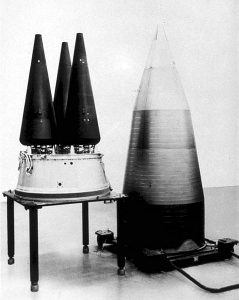
The study in question came about because Marylia Kelley, of Tri-Valley CARES, and NukeWatch’s Director, Jay Coghlan, suggested to congressional staff that it be done. But they wanted to ask independent scientists (the JASONs) to do it – instead just NNSA did it. And NNSA dodged the central congressional requirement to compare the benefits and costs of the Interoperable Warhead vs a “conventional” life extension program for the Air Force’s W78 ICBM warhead. NNSA simply said a conventional life extension program would not meet military requirements and therefore summarily dismissed it (no further explanation). Marylia and Jay had the opportunity to discuss this with the relevant congressional staffer who said this ain’t over.
New Estimate ($377B) Raises Cost of Cold War Cleanup (Again)
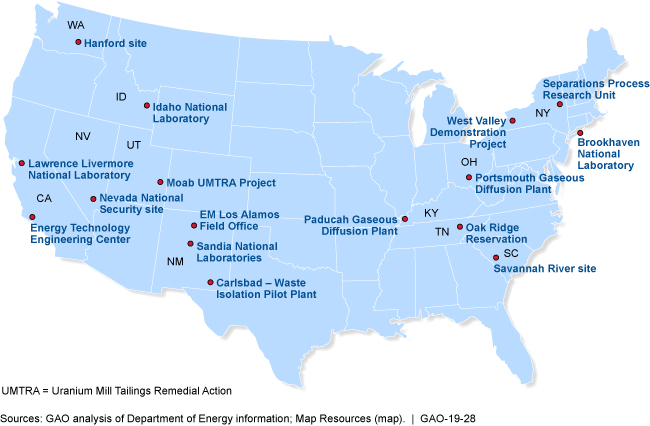
At some point, DOE will have to admit that it has no idea what it will cost to cleanup the Cold War nuclear weapons complex sites. DOE should stop making more wastes until the existing wastes are remediated. The new estimate is more that twice the amount that has been spent in total since cleanup began in 1989, with the most difficult sites still to come.
We’ve said it before and we’ll say it again – Clean Up, Don’t Build Up!
The thing is that the new $377 billion estimate includes leaving much of the waste behind.
Program-Wide Strategy and Better Reporting Needed to Address Growing Environmental Cleanup Liability GAO-19-28: Published: Jan 29, 2019. Publicly Released: Jan 29, 2019.
The Department of Energy is tasked with cleaning up waste from Cold War nuclear weapons production, much of which is hazardous or radioactive. The department’s Office of Environmental Management estimates that future work could cost at least $377 billion—$109 billion more than last year’s estimate.
Plutonium Pit Production NEPA Talking Points
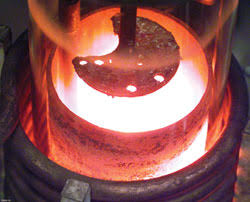
The National Environmental Policy Act (NEPA) is the landmark environmental law which requires executive agencies to give the public the opportunity to formally review and comment on major federal proposals. These talking points outline the history of the Department of Energy’s NEPA compliance on its various proposals concerning the production of plutonium pits (the fissile cores of nuclear weapons). The conclusion is that DOE’s semi-autonomous National Nuclear Security Administration (NNSA) is legally required to prepare a supplemental programmatic environmental impact statement (PEIS) on its current plan to expand plutonium pit production.
There are at least three reasons why NNSA must complete a supplemental programmatic environmental impact statement for expanded plutonium pit production:
1) Implementing regulations for the National Environmental Policy Act stipulate that “DOE shall prepare a supplemental EIS if there are substantial changes to the proposal or significant new circumstances or information relevant to environmental concerns…” 10. C.F.R. § 1021.314
2) As precedence, since 1996 there have been five programmatic environmental impact statements related to pit production and its expansion. It is legally unlikely that NNSA could implement its current plan to expand plutonium pit production without a new supplemental PEIS.
3) Now that NNSA is planning to produce more than 50 pits per year (or more than 80 pits under multiple shift operations), it is obliged by the 1998 court order to prepare a new PEIS.
Continue reading
“Preliminary” Research Pushes Economic Impact Boundaries for LANL
While Sandia, LANL, and Journal Statements Leave Many Questions
A January 15 Los Alamos National Laboratory (LANL) press release reviewed preliminary research from the University of New Mexico’s Bureau of Business and Economic Research (BBER). The research claimed that the “average annual total impact on economic output across New Mexico from 2015 to 2017 was $3.1 billion.” This implies that BBER estimates that LANL contributes an average of $3.1 billion a year to the state’s economy annually.
This $3.1B conclusion is based on unreleased data and pushes the boundaries of accepted economic theory. The authors or the title of the research are not given. No estimate of when the final report of this will be released is given. Is the research even complete? Will the results change? Has it been reviewed?
NukeWatch Joins Suit To Stop WIPP Expansion
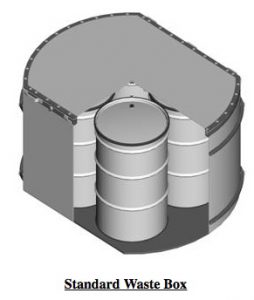
NukeWatch Joins Suit To Stop WIPP Expansion
On January 17, 2019, Southwest Research and Information Center (SRIC) and Nuclear Watch New Mexico (NWNM) filed an appeal in the New Mexico Court of Appeals to overturn the New Mexico Environment Department (NMED) approval of the Waste Isolation Pilot Plant (WIPP) Disposal Volume permit modification, which was issued on December 21, 2018.
The modification would allow expansion of WIPP’s capacity by approximately 30 percent and was issued over the repeated opposition of many New Mexico organizations.
NNSA Plans to Replace the W78 Warhead
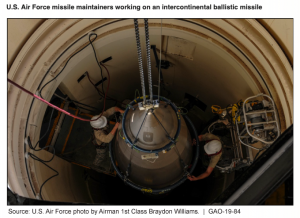
NUCLEAR WEAPONS:
NNSA Has Taken Steps to Prepare to Restart a Program to Replace the W78 Warhead Capability
GAO-19-84: Published: Nov 30, 2018. Publicly Released: Nov 30, 2018.
The National Nuclear Security Administration is preparing to restart a program to replace the W78 nuclear warhead, which is used in Air Force intercontinental ballistic missiles. The goal is to produce the first W78 replacement warhead in fiscal year 2030. Pending further study, this replacement warhead may also be used in Navy submarine launched ballistic missiles.
Please Help Support NukeWatch
![]()
Dear Friends of Nuclear Watch New Mexico:
The Los Alamos and Sandia Labs are the tip of the spear for a one-trillion dollar “modernization” program that will completely rebuild every type of warhead in the nuclear stockpile while giving them new military capabilities. This so-called modernization program will also rebuild the production side of the Department of Energy’s nuclear weapons complex, including the proposal to quadruple production of plutonium pit bomb cores at the Los Alamos National Laboratory (LANL). This so-called modernization will be at enormous cost to the taxpayer and our disappearing middle class, robbing citizens of better schools, highways, hospitals, etc.
Join In Giving Tuesday
 Join In Giving Tuesday
Join In Giving Tuesday
We have two days for getting deals – Black Friday and Cyber Monday. On #GivingTuesday, we have a day for giving back. Together, people are creating a new ritual for our annual calendar. #GivingTuesday is the opening day of the giving season.
Founded by the team in the Belfer Center for Innovation & Social Impact at 92nd Street Y, #GivingTuesday is a global giving movement that has been built by individuals, families, organizations, businesses and communities in all 50 states and in countries around the world. This year, #GivingTuesday falls on November 27. #GivingTuesday harnesses the collective power of a unique blend of partners to transform how people think about, talk about, and participate in the giving season. It can inspire people to take collective action to improve their communities, give back in better, smarter ways to the charities and causes they believe in, and help create a better world. #GivingTuesday demonstrates how every act of generosity counts, and that they mean even more when we give together.
Belen passes resolution opposing nuclear waste transportation
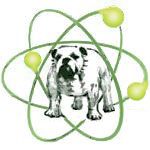
Belen passes resolution opposing nuclear waste transportation
NISG (Nuclear Issues Study Group) worked to get a resolution opposing the transportation of High Level Radioactive Waste in front of the City of Belen. The Belen City Council passed the resolution on Nov. 19th! It was 3 votes yes and 1 abstention. Belen is the 18th City or county or chapter house to pass it in New Mexico and Texas.
Read more about it here
Santa Fe County passed a similar resolution – A Resolution in the Interest of Protecting Our Lives, Land and Water From Radioactive Waste Risks.
Read more about it here
Citizens Oppose Plans For New Mexico Nuclear Waste Dump
Citizens Oppose New Mexico Nuke Dump
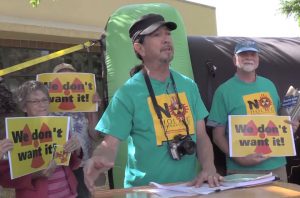
“We Don’t Want It!”
The Nuclear Waste Policy Act of 2018, HR 3053, known as the Shimkus Bill, has passed the House on its way to the Senate.
It calls for restarting the failed Yucca Mountain Project in Nevada, and establishing a system of Consolidated Interim Storage (CIS) sites for radioactive waste around the country until Yucca is operational.
First on the list of possible ‘temporary’ CIS dumps is a site proposed by Holtec International and the local Eddy-Lea Alliance just outside Hobbs, New Mexico. Its just over the border from Andrews, Co., Texas – where another high level nuke waste dump is also proposed.
Proponents tout it as an economic boon. Opponents see as it a public health and environmental disaster.
Planned to eventually hold more metric tons of waste than Yucca itself will be designed for, the Hobbs site could well become America’s de facto national dump site, if Yucca never gets built.
At a recent series of Nuclear Regulatory Commission community meetings on the proposed site, opposition was strong from many of New Mexico and Texas public sectors.
A press conference by local citizens laid out their views.
“We Don’t Want It!” Halt Holtec campaign continues. Opposition to proposed nuke dump is strong and growing.
NNSA Releases Expanded 2012 Performance Evaluation Reports
In response to a request from Nuclear Watch New Mexico, the National Nuclear Security Administration has released to us expanded versions of the 2012 Performance Evaluation Reports (PERs) for seven nuclear weapons complex sites. (The report for the Savannah River Site was not given to us.) The reports are used by NNSA to decide how much Award Fee it will give its nuclear weapons site contractors each year.
Design issues for the proposed Uranium Processing Facility (UPF) cost taxpayers over a 1/2 billion dollars. A statement from the Oak Ridge Environmental Peace Alliance (OREPA) sheds light on the FY2012 Y-12 Performance Evaluation Report –
NNSA admitted publicly in October, five months after it first learned about it, that it had run into a “space/fit issue” with the UPF design. The building, as it approached 80% design completion, would not hold all the equipment it needs to hold…
“The engineering plan delivered on October 19, reported a TPC cost impact of $539M and 13 month impact to the overall project schedule as a result of the Space/Fit issue, effectively using 45% of the NNSA contingency established during CD-1 Reaffirmation in April.” (Performance Evaluation Report for Babcock and Wilcox Y-12 Technical Services, LLC, Evaluation Period: October 1, 2011 through September 30, 2012, p.7)
…more soon…
How Do You Spell PASSWORD? LANL Gets Bad Cyber Report
How Do You Spell PASSWORD? LANL Gets Bad Cyber Report
It turns out that cyber security for running supercomputing networks at a national nuclear weapons laboratory may not be much different than cyber security for the rest of us emailing, social networking, and watching kitten videos. All of us need to reasonably vigilant with passwords and software updates. The difference is that when you and I use lame passwords and don’t update our software, we don’t put national security at risk.
The DOE Investigator General (DOE IG) released a report that identified continuing concerns in LANL cyber security program. These concerns have been going on for years. A 2006 report revealed that critical cyber security internal controls and safeguards were not functioning as intended and monitoring by both laboratory and Federal officials was not adequate. Weaknesses with LANL’s cyber security program were also identified at least as far back as 2002.
A temporary shutdown of the Lab for nearly seven months (July 2004 to January 2005) because of a security flap might have cost as much as $370 million, but the exact amount can’t be calculated because of the way the lab recorded its activities according to General Accounting Office congressional investigators in 2005. Apparently, exact amounts are hard for the Lab to come up with. The DOE IG, for its cyber report, said, “Although LANL spends a significant amount of funds on information technology (IT) activities, we were unable to obtain an accurate amount due to the Laboratory’s limited ability to track its IT spending.”
How do you spell PASSWORD?
The DOE IG found that, “Network servers and devices were configured with default or easily guessed login credentials or required no authentication. For example, 15 web applications and 5 servers were configured with default or blank passwords.” Additionally, two network servers had the possibility to accept connections from anybody without the use of authentication or similar access controls. Also, 10 network servers could have allowed unauthorized remote control.
Those pesky software updates –
And, “LANL had not fully implemented existing security patch management and vulnerability management procedures. Specifically, tests of 191 network servers supporting LANL’s financial applications and data or providing core network services revealed that 73 (38 percent) were running operating systems and client applications without current security patches…” The DOE IG also found that LANL continued to maintain a significant number of operating systems, client applications and other various software that was no longer supported.
To be fair, the DOE IG reported that LANL “improved the protection of national security systems and data through the elimination or disablement of data ports on machines containing classified information.” This partially refers to the Lab’s low-tech program of injecting a popular two-stage epoxy into USB ports. I’m not sure that qualifies as an IT solution.
No passwords. No updates. How does this happen at nuclear weapons laboratory? Two things – First, the Lab contractor does not perform. Second, oversight is lacking. The DOE IG stated that, “The issues identified occurred, in part, because of a lack of effective monitoring and oversight of LANL’s cyber security program by the Los Alamos Site Office, including approval of practices that were less rigorous than those required by Federal directives. “ The Los Alamos Site Office is a DOE office and is tasked with providing immediate federal oversight of the Lab and making sure that our taxpayers’ dollars are spent wisely.
Unfortunately, DOE continues to relax its grip of oversight of the Labs. Continuing cyber security issues are only one manifestation of this letting go. We need a strong DOE Secretary, a strong NNSA administrator, and strong Congressional oversight as we head towards zero nukes if we hope to hold the nuclear weapons complex contractor accountable.
The Lab’s New, $400 million, Plutonium Laboratory Springs Its First Leak
The Lab’s New, $400 million, Plutonium Laboratory Springs Its First Leak
On January 22, 2013 representatives of the Los Alamos National Laboratory discovered the presence of a diesel spill from an above ground storage tank system at the LANL Technical Area 55. The spill was from the new Radiological Laboratory Utilities Office Building’s (RLUOB’s) 12,000-gallon emergency generator diesel storage tank. The RLUOB is the recently completed first phase of the CMRR project. The main phase of the project, the CMRR Nuclear Facility (estimated at #6 billion), has been deferred for at least 5 years and will probably next be proposed next as a smaller project, if at all.
From the reports, it is unclear how long the sump pump union had been leaking before the spill was noticed. A leak detector alarm first went off in November. The Lab estimates that 350 gallons overflowed out a sump and spilled onto the ground, and workers have removed 5 cubic yards of contaminated soil. LANL and the State Environment Department Petroleum Storage T ank Bureau are working to figure out if more soil needs to be removed.
ank Bureau are working to figure out if more soil needs to be removed.
WIPP Proposes to Eliminate Waste Sampling – Comments Needed!
WIPP Proposes to Eliminate Waste Sampling – Speak Out!
Since the Department of Energy (DOE) opened the Waste Isolation Pilot Plant (WIPP) in 1999, the transuranic (TRU-plutonium-contaminated) waste has been subjected to chemical sampling and laboratory analysis to determine what toxic chemicals are present before the waste can be shipped to WIPP. The WIPP operating permit issued by the New Mexico Environment Department (NMED) has required headspace gas sampling of non-solidified waste and coring of solidified waste to help determine toxic chemicals and their concentrations. DOE now wants to eliminate all requirements for headspace gas and solids sampling from the WIPP permit. But people can speak out about DOE’s plans!
Read the fact sheet here.
Submit written comments to the New Mexico Environment Department (NMED).
Tell NMED:
I am very concerned that eliminating sampling of waste bound for WIPP would reduce health and safety protections because such analysis is still needed, including for the many waste streams that have not yet been sampled. NMED should deny the request. Any future requests to reduce or eliminate sampling should only be made after the kind of systematic approach recommended by the National Academy of Sciences is carried out and made public and after representative sampling is done for waste streams that have not yet been shipped to WIPP.
The deadline for written comments to NMED is February 18, 2013. Submit to:
Trais Kliphuis, New Mexico Environment Department, 2905 Rodeo Park Drive East, Building 1, Santa Fe, NM 87505, or
E-mail: trais.kliphuis@state.nm.us
The complete 301-page permit modification request (13 MB) can be found at:
http://www.wipp.energy.gov/rcradox/rfc/Class_2_PMR.pdf
GOVERNMENT MEMO SLAMS BECHTEL FOR MALFEASANCE, SAFETY VIOLATIONS AT HANFORD NUCLEAR SITE
This is from our friends at Hanford Challenge (www.hanfordchallenge.org). Bechtel is the major operator of Los Alamos National Laboratory.
Press Release
Immediate Release
For more information contact: Tom Carpenter, 206-419-5829 tomc@hanfordchallenge.org
August 28, 2012
GOVERNMENT MEMO SLAMS BECHTEL FOR MALFEASANCE, SAFETY VIOLATIONS AT HANFORD NUCLEAR SITE
Memo Urges DOE to Remove Bechtel as the Design Authority, Warning Bechtel “is not competent to complete their role”
Seattle, WA: Hanford Challenge today released a high-ranking Director’s memorandum that urges termination of the key duties of government contractor, Bechtel National, Inc. (“Bechtel”; “BNI”). A litany of charges question whether Bechtel should continue its role at the Hanford nuclear site, including a long history of incompetence, misleading the government, overcharging, and unsafe designs.
The memo states, “[t]he number and significance of these issues indicate that Bechtel National Inc. is not competent to complete their role as the Design Authority for the WTP [Waste Treatment Plant], and it is questionable that BNI can provide a contract-compliant design as Design Agent.”
The memo continues, noting that “[t]he behavior and performance of Bechtel Engineering places unnecessarily high risk that the WTP design will not be effectively completed. . .”
The August 23, 2012 memo was prepared by the Department of Energy’s WTP Engineering Division Director who oversees the Waste Treatment and Immobilization Plant. It is titled “Summary of Actions and Design Outcomes that Erode Confidence in the ability of Bechtel National Inc. to complete their assigned role as Design Authority for the WTP,” it includes a 19- page attachment, and it is addressed to the Hanford Site Manager. The memo begins:
“This memorandum documents 34 instances and technical issues in which Bechtel National Inc., acting as Design Authority for the Waste Treatment and Immobilization Plant (WTP) has provided design solutions and technical advice to the Department of Energy which either:
• was determined to be factually incorrect,
• provided a design solution that was not technically defensible, technically viable, or was technically flawed considering identified requirements,
• provided a design solution that was not safe for the WTP operators, or designs that did not comply with the safety basis,
• provided a design solution that represented higher River Protection Project life cycle operating costs compared to other alternatives,
• provided a design solution that was difficult and costly to verify considering other alternatives. thereby increasing WTP completion costs and extending the WTP completion schedule,
• provided a design that was new and unique and does not clearly provide benefits compared to existing technologies and which required special qualification testing,
• provided an installed equipment system that did not meet safety requirements or was not adequately inspected following installation even when defects became known, or
• did not represent best value to the Government in terms of design costs, operating costs or completion schedule.”
The Hanford Waste Treatment Plant is one of the world’s largest and most expensive environmental remediation projects. The current plant is the fourth attempt to build a treatment facility to convert radioactive waste into glass at Hanford, it is a decade behind schedule and with a price tag of approximately at $13 billion, it is at least 250% over budget. The Department of Energy (“DOE”) recently suspended much of the project’s design and construction activities, pending resolution of outstanding safety and technical concerns.
The memo further states, “DOE Engineering Staff have uncovered findings at a nearly constant rate since 2008. The rate of identification is constant, indicating systemic problems in the WTP design process and in BNI’s role as Design Authority. The number and rate of problems identified is indicative that issues are not being resolved.”
Hanford Challenge Executive Director, Tom Carpenter, posits: “the leaked memo puts the Waste Treatment Plant’s woes into sharp relief. This memo details exhaustive and disturbing evidence of why Bechtel should be terminated from this project and subject to an independent investigation. We already knew of Bechtel’s record of suppressing its own engineers’ concerns and retaliating against whistleblowers, and now we see evidence that exhibits a shocking and inexcusable lack of attention to safety for both workers and the public.”
The Engineering Director’s memo recommends, “the role of the WTP Design Authority should be immediately removed from BNI. The DOE should evaluate and select a preferred option to establish an Independent Design Authority for the WTP that will represent the interests of the DOE and the DOE operator.”
+++++++++++++++++++
DOE Memo can be found at www.hanfordchallenge.org
Trinity Day — a good day to get money from the Fed?
Please check out Stephanie’s blog
Particle Beams
“Luminous Quanta of Divine Intelligence…” dispelling the nuclear delusion
Trinity Day — a good day to get money from the Fed?
Batter my heart, three-person’d God. — John Donne, “Trinity”
Yesterday was the 67th anniversary of the very first atomic bomb test in the New Mexico desert, and alas for us, it was a success.
Across the globe, we still have 20,000 bombs ready to go, many of them on high alert.
Commemorating this event and its consequences were three different developments in New Mexico.
The first and most incongruous was news of a delegation embarking on that very day and heading to Washington, DC, to sell someone (not specified in the Los Alamos Post story) how much it means to the state of New Mexico to have the Labs here.
Nice way to celebrate the anniversary, que no? Drinks afterwards at the Capitol?
The delegation was composed of nearly 20 members of the business community accompanied by a representative from Governor Martinez’ office. We might have expected the head of the Chamber of Commerce, Simon Brackley, to be there, but it was a bit of a surprise to see Lilian Montoya Rael, a Board member from Christus St. Vincent’s Hospital.
But I suppose that the Labs, being so detrimental to health, are an indispensable asset to the Hospital.
Speaking of health, the second event, in marked contrast to the humble fundraising efforts of a few of our respected citizens, addressed the reality — the real impact of the bomb test on the lives of citizens, in this case the citizens of Tularosa, a small village that exists outside the presumed boundary of fallout that was expected from that event. These men, women and children have experienced a disproportionately higher-than-ever rate of cancers and other disabling conditions. July 16 was named Nuclear Disasters Day in Tularosa. They celebrated with luminarias at the town baseball field!
Last but not least, July 16 marks the first day of the Los Alamos Hunger Strike initiated by Alaric Balibreras. Thirty strikers have joined him in his plea to have a conversation with Those in Charge of the Lab’s affairs about coming up with a Plan to actually change the Lab’s Mission, currently the production of a-bombs (as posted on the Lab’s website), to production of Things that are Good for Us. (Remember “Better Living through Chemistry?” Such were the slogans that set off the hippie resistance of the 60s, and I’m told that the planets are aligned in a similar pattern today!!)
And which way will it go? Will the delegation of business people receive more money from Washington to produce more bombs, an activity so lucrative to the state that they can’t bear to let it go… or will this year be the year of The Rise of the Little People demanding an end to this profligacy and waste? Stay tuned. Alaric plans to fast until Nagasaki Day, August 9, anniversary of the day in 1945 when the US used the first plutonium bomb against the residents of that city, killing 130,000 on site and more later.
Enough, he says, and we say with him: Let’s have a Change of Heart, For a World of Beauty! Raise an empty glass with 30 hunger strikers and join them if you wish: you’ll find them on Facebook, at Los Alamos Hunger Strike.
We will be following the strike throughout the 21 days with updates and interviews. Here’s one newsflash from yesterday:
Los Alamos, July 16, 2012
STANDING AT THE GATES OF THE LAB some 20 protestors, most of them from Trinity Abolition, an Albuquerque group which protests at the Lab on a regular basis, as well as members of the hunger strike, joined hands outside the gates of the lab. “Lab people came down and took our pictures and got our names,” reports Ellie Voutselas of Pax Christi, one of the fasters.
Alaric then moved over to Ashley Pond, the original site of the Lab and now a public park, where he was joined by a young striker whose dog set up a howl for the duration. Guess that puppy has a few things to say about nuclear weapons, but the canine may provide an unneeded distraction if this keeps up.
Lab lacks ability to estimate emergency response as it also underestimates risk
Lab lacks ability to estimate emergency response as it also underestimates risk
There has been much in the recent news about Los Alamos National Laboratory underestimating how much radiation could leak from the nuclear weapons production plutonium lab after a major earthquake and fire. Read the POGO article here.
The Defense Nuclear Facilities Safety Board Report is here.
Among other problems, LANL computer models credited sheetrock walls with surviving an earthquake.
In a recently released May report, the Department of Energy’s very own oversight Department finished a separate review titled, “Independent Oversight Review of Site Preparedness for Severe Natural Phenomena Events at the Los Alamos National Laboratory”, that also questions the Lab’s safety procedures.
The Health Safety and Security Office (HSS) of Safety and Emergency Management Evaluations performed this independent review to evaluate emergency response capabilities at the Lab and how the Lab maintained them in a state of readiness in case of a severe natural phenomena event. The review showed that LANL would have trouble responding quickly with the appropriate emergency response in the case of a serious natural event.
As one of the conclusions states – “LANL does not have an adequate means for determining quickly whether an event occurring at the CMR facility, a criticality event at TA-55 PF-4 facility, or a severe natural phenomena event at either facility involves a significant quantity of HAZMAT and requires implementation of corresponding onsite protective actions or issuance of appropriate offsite protective action recommendations.” (Pg. 38)
For example, the Emergency Action Levels currently in the Lab’s Emergency Plan Procedure:
• Do not reflect the CMR Emergency Planning Hazards Assessment isolation and downwind protective action distances for the majority of the events
• Do not provide Emergency Action Levels for two severe natural phenomena events (earthquake and wildland fire) in the CMR Emergency Planning Hazards Assessment
• Use a criticality alarm system as an Emergency Action Level entry indicator for a criticality event at CMR, even though CMR is not equipped with a criticality alarm system
• Do not use the PF-4 criticality alarm system as an Emergency Action Level entry indicator for the criticality event analyzed in the TA-55 Emergency Planning Hazards Assessment.
In addition, the Lab’s generic natural disaster Emergency Action Levels do not provide sufficient information to accurately categorize and/or classify a severe natural phenomena event.
And LANL’s planning for onsite protective actions and offsite protective action recommendations provided in the Emergency Action Levels did not fully consider facility or site conditions for the analyzed events.
The report continues. The Independent Oversight observed outdated and incorrect information in the current set of CMR and TA-55 PF-4 Emergency Action Levels. Further, the generic Emergency Action Levels for severe natural phenomena events were not based on the potential for or an actual uncontrolled release of HAZMAT and are not linked to protective actions or protective action recommendations.
Additionally, the pre-planned protective actions for a TA-55 PF-4 seismic event are limited to shelter-in-place when there could be high radiation levels, and no effective shelters are available.
So, we have two different government agencies questioning safety after the Lab received a record $83 million in award bonuses.
These reports are another example of why the Lab must shut down plutonium operations now.
LANL loses track of nuclear materials
LANL loses track of nuclear materials
Plutonium operations placed in standby mode
In an April 20, 2012 report, the Safety Board charged with oversight of defense nuclear facilities reported that the system used to track nuclear materials in the Plutonium Facility at Los Alamos National Laboratory was operating erroneously. The system apparently only kept track of 1,700 out of 13,000 containers of nuclear “materials at risk” (MAR). This omission caused the facility to exceed its limits for MAR located in individual containers and outside of gloveboxes at least 15 times.
If one is operating a facility with large quantities of fissionable nuclear materials it is very important to know where the materials are at all times because stacking too much plutonium in one place can cause a criticality event or worse. After the error was noticed, the Lab manually started to verify container MAR amounts manually. “To date, fifteen containers, all housed in the facility’s vault, have been identified with contents that exceed the MAR limit of 7500 g WG-Pu [Weapons Grade Plutonium] equivalent.” That’s a lot to lose track of because these limits help the facility to comply with the seismic requirements of operations in the Lab’s earthquake fault zone.
Normal operations have been terminated in the 150,000 square foot Plutonium Facility and the facility has been placed in “Standby Mode.” How much does a shutdown cost taxpayers?
How long has the Lab violated these limits? The report states that the tracking error was introduced during software development, apparently due to a “miscommunication” between the software developers and the security personnel. The MAR tracker program performs other required MAR limit surveillances in the facility. Are these other surveillances reliable? This incident also calls into question other Lab software, such as programs that model contaminant transport.
It is unclear if the plutonium facility has restarted operations. The Safety Board reports usually are released about a month after they are written.
The Defense Nuclear Facility Safety Board Report is here.
It is still annual compensation paid for by the taxpayers
I’d like to respond to the news stories out lately concerning the Director’s salary at the Los Alamos National Laboratory. Following our press release Wednesday, the Lab released their reply. It was reported by both the Albuquerque Journal North and the LAMonitor.
LANL Says Pension Boosted Director’s Compensation By Mark Oswald / Albuquerque Journal on Fri, Apr 20, 2012
Nuke Watch assails lab salary increase By John Severance, LA Monitor, Thursday, April 19, 2012 at 12:32 pm (Updated: April 20, 9:08 am)
From the monitor article –
“According to its computations, Charlie McMillan, the LANL director, had a salary of $1,081,059 in 2011. In 2009, the salary was $800,348 and in 2005, the year before the management of the lab was awarded to Los Alamos National Security, LLC, a corporation including the University of California, Bechtel Corporation, URS and B&W, the salary was $348,000.”
BTW, it’s not our “computations.” The compensation levels we quote come from federal reporting on economic stimulus funding.
In response, the Lab states, “The majority of the figure reported under DOE stimulus funding guidelines is an increase in pension value.” Can anyone explain what this means? Our economic experts are at a loss. Until I am straightened out, which I eagerly await, the statement will mean to me that the increases of the Director/President’s annual compensation are mostly due to increased pension contributions.
Whatever it is, it is still annual compensation.
The Lab response continues – “Also included are salary, life insurance, health benefits, and other total compensation.” I repeat, whatever the “increase in pension value” is, it is still annual compensation.
The Lab response continues – “The portion of the director’s annual salary reimbursable by the government is about 35 percent of the reported figure and is comparable to previous director salaries, adjusted for inflation.” That may be true, but the remaining 65% of the $1M annually going to the LANL Director/LANS President is coming from the contractor Los Alamos National Security, LLC (LANS), of which he is president of the executive committee of the board of directors. The statement continues – “Any amount above the federal maximum comes from LANS performance fees and is not reimbursable by the government.” But the LANS performance fees are paid by the federal government, so ultimately it is still the taxpayer that is paying the LANL’s Director’s total salary.
It is still annual compensation paid for by the taxpayers.
Before the LANL management contract was privatized and became for-profit in June 2006 the LANL Directors were getting just that salary directly reimbursable by the government. Now they get that plus the larger LANS amount on top of it.
Two Upcoming Events
Two upcoming events
Sunday Mornings @ The Travel Bug
April 22, Sunday, 11 am
839 Paseo de Peralta, Santa FeJay Coghlan, Executive Director Of Nuclear Watch New Mexico
in Conversation with Michelle Victoria – NukeFreeNow on the work Jay has
done over the last 22 years on nuclear safety and what Michelle is planning
for the NukeFreeNow.
http://www.journeysantafe.com/travelbug.php
Travel Bug is an independent travel specialty store in Santa Fe, NM,
839 Paseo de Peralta 505-474-1457And
CMRR Public Meeting
Wednesday, April 25 from 6:30 – 8:30
Fuller Lodge, Los AlamosThe Chemistry and Metallurgy Research Replacement (CMMR) Project is the
Lab’s $6 billion dream facility that would enable expanded production
capabilities for plutonium nuclear weapons components. The Obama
Administration has recently proposed deferring the project for 5 years,
which will likely lead to its termination.This will be the 13th semi-annual public meeting required as part of a 2005
settlement between DOE/LANL and an network of community groups:
• Concerned Citizens for Nuclear Safety
• Embudo Valley Environmental Monitoring Group
• Loretto Community
• New Mexico Environmental Law Center
• Nuclear Watch New Mexico
• Peace Action New Mexico
• Tewa Women UnitedYou are invited to come and be inspired as LANL CMRR project personnel give
updates on the project while our network of community groups give updates of
our concerns.
Defense Dept. Memo Criticizes Cost of Nuclear Weapons Labs While Los Alamos Director’s Salary Nearly Triples
Our colleagues and friends at the Project on Government Oversight (POGO) have released an explosive report based on a leaked Department of Defense memo concluding that “The Department of Energy’s network of privately-operated nuclear weapons laboratories are riddled with waste, redundancies and lackluster scientific standards.” POGO also found that “that seven of the top 15 officials at the three DOE nuclear labs make more than $700,000 per year, with one earning $1.7 million—more than the president of the United States and many government executives.”
Coincidentally, Nuclear Watch New Mexico had been independently compiling data on the salaries of the three laboratory directors, as presented in the table below. It shows that the salary of the Los Alamos Director has nearly tripled since for-profit management began in June 2006, even as the Lab is cutting some 600 jobs. As seen below, privatization of the nuclear weapons labs’ management contracts has resulted in directors’ salaries far above average in both the federal government and the private sector.
The DoD memo leaked by POGO contains the following admirable passage on good governance:
Diminishing Public Accountability. Without a strong yardstick, our government cannot govern well — not even if it retains the best and brightest on contract. The government’s own assets must capably bear the responsibility for decisions that affect national interests, and they must maintain public confidence by the manner in which those decisions are made.
In contrast, the directors of the three nuclear weapons labs (the Los Alamos, Sandia and Lawrence Livermore National Laboratories) wear two hats, first as lab directors, but secondly as the presidents of the board of directors of the for-profit limited liability corporations (LLCs) that run the labs. That may be a questionable conflict of interests, in which the LLCs are enjoying record profits from issues that deeply “affect national interests” (i.e., nuclear weapons) while the salaries of their “CEOs” (the lab directors) are exploding.
Arguably the lab directors have not maintained public confidence in the decisions they make because of the general trend of increasingly withholding crucial public information. One example is the Performance Evaluation Reports that rate contractors’ performance and determines the amount of taxpayers’ money awarded to them. Those reports were publicly available until 2009 when the National Nuclear Security Administration (NNSA) began to withhold them, and became recently available again only after NukeWatch NM sued for them under the Freedom of Information Act.
NNSA awarded the limited liability corporation that runs Los Alamos Lab $74.2 million for FY 2010, followed by $83.7 million in profit for FY 2011, a 13% increase in one year, and 10 times more than what the University of California (UC) use to be awarded when it was LANL’s sole nonprofit manager. Jay Coghlan, NukeWatch Director, commented, “In today’s political and economic climate citizens need to remain vigilant that for-profit corporate interests don’t corrupt serious national issues. This very much applies to how our nuclear weapons labs are run as well. We specifically call upon Los Alamos Lab to fully explain to northern New Mexicans why it needs to cut some 600 jobs while at the same time the for-profit management corporation is enjoying record profits and the Director’s salary has nearly tripled in six years.”
# # #
All data on nuclear weapons labs directors’ salaries are from:
https://web.archive.org/web/20220201173130/http://www.upte.org/LosAlamos/salaries/salaries.html
POGO’s press release “Leaked Defense Memo Criticizes the Department of Energy’s Push to Expand Nuclear Weapons Laboratories” is at http://www.pogo.org/pogo-files/alerts/nuclear-security-safety/nss-nwc-20110418-nuclear-waste-dept-of-energy.html
POGO’s detailed letter to congressional committees on these issues is at http://www.pogo.org/pogo-files/letters/nuclear-security-safety/nss-nwc-20120418-nuclear-weapons-labs.html
To read the leaked DoD memo, click here https://web.archive.org/web/20211025065956/http://pogoarchives.org/m/nss/new-missions-for-the-nuclear-weapons-labs-11-16-2011.pdf
551 W. Cordova Rd., #808, Santa Fe, NM 87505-4100 • Voice and fax: 505.989.7342
info@nukewatch.org • www.nukewatch.org • https://nukewatch.org/watchblog/
http://www.facebook.com/NukeWatch.NM

